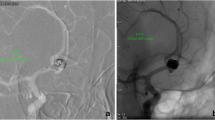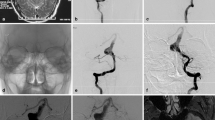Abstract
Introduction
Vertebrobasilar dissection is an uncommon cause of subarachnoid haemorrhage (SAH) that carries a high risk for early repeat haemorrhage. The need for rapid treatment of this disease entity is without question; however, the best method for treatment is still undetermined. Here, we present our results using the stent-in-stent technique, without coiling, for these patients and propose that it is a viable treatment strategy.
Methods
We identified in our local database for neurointerventional therapy, between 1st October 2000 and 1st January 2014, 93 patients with potential subarachnoid haemorrhage secondary to vertebrobasilar pathology. After review of the clinical notes and imaging, 15 were found to have presented with subarachnoid haemorrhage and treated with stents alone. All dissections were spontaneous with no history of preceding trauma. The ages ranged between 46 and 71 years (mean 61 years).
Results
All patients presented with Fischer grade 4 SAH and had a visible pseudoaneurysm. The pre-operative GCS varied with two patients scoring 3, one patient scoring 6 and the remaining 12 patients scoring 8 or above. All cases were subjected to stent-in-stent treatment alone. We did not experience any intra-procedural complications. In our series, eight patients had full recovery with a Glasgow Outcome Scale (GOS) of 5, three had moderate disability (GOS 4), one had severe disability (GOS 3), and three patents died, one patient from stent thrombosis or re-bleeding and two from their initial SAH.
Conclusion
The stent-in-stent technique represents a viable reconstructive endovascular surgical technique with a low risk of intra-procedural complication and post-operative repeat haemorrhage.





Similar content being viewed by others
References
Sasaki O, Ogawa H, Koike T et al (1991) A clinicopathological study of dissecting aneurysms of the intracranial vertebral artery. J Neurosurg 75:874–882. doi:10.3171/jns.1991.75.6.0874
Yamaura A, Watanabe Y, Saeki N (1990) Dissecting aneurysms of the intracranial vertebral artery. J Neurosurg 72:183–188. doi:10.3171/jns.1990.72.2.0183
Berger MS, Wilson CB (1984) Intracranial dissecting aneurysms of the posterior circulation. Report of six cases and review of the literature. J Neurosurg 61:882–894. doi:10.3171/jns.1984.61.5.0882
Mizutani T, Aruga T, Kirino T et al (1995) Recurrent subarachnoid hemorrhage from untreated ruptured vertebrobasilar dissecting aneurysms. Neurosurgery 36:905–911, discussion 912–913
Rabinov JD, Hellinger FR, Morris PP et al (2003) Endovascular management of vertebrobasilar dissecting aneurysms. AJNR Am J Neuroradiol 24:1421–1428
Anxionnat R, de Melo Neto JF, Bracard S et al (2008) Treatment of hemorrhagic intracranial dissections. Neurosurgery 62:1525–1531. doi:10.1227/01.neu.0000333818.25520.90
Kurata A, Ohmomo T, Miyasaka Y et al (2001) Coil embolization for the treatment of ruptured dissecting vertebral aneurysms. AJNR Am J Neuroradiol 22:11–18
Yamada M, Kitahara T, Kurata A et al (2004) Intracranial vertebral artery dissection with subarachnoid hemorrhage: clinical characteristics and outcomes in conservatively treated patients. J Neurosurg 101:25–30. doi:10.3171/jns.2004.101.1.0025
Otawara Y, Ogasawara K, Ogawa A, Kogure T (2002) Dissecting aneurysms of the bilateral vertebral arteries with subarachnoid hemorrhage: report of three cases. Neurosurgery 50:1372–1374, discussion 1374–1375
Ali MJ, Bendok BR, Tawk RG et al (2002) Trapping and revascularization for a dissecting aneurysm of the proximal posteroinferior cerebellar artery: technical case report and review of the literature. Neurosurgery 51:258–262, discussion 262–263
Yamaura I, Tani E, Yokota M et al (1999) Endovascular treatment of ruptured dissecting aneurysms aimed at occlusion of the dissected site by using Guglielmi detachable coils. J Neurosurg 90:853–856. doi:10.3171/jns.1999.90.5.0853
Friedman AH, Drake CG (1984) Subarachnoid hemorrhage from intracranial dissecting aneurysm. J Neurosurg 60:325–334. doi:10.3171/jns.1984.60.2.0325
Halbach VV, Higashida RT, Dowd CF et al (1993) Endovascular treatment of vertebral artery dissections and pseudoaneurysms. J Neurosurg 79:183–191. doi:10.3171/jns.1993.79.2.0183
Benndorf G, Herbon U, Sollmann WP, Campi A (2001) Treatment of a ruptured dissecting vertebral artery aneurysm with double stent placement: case report. AJNR Am J Neuroradiol 22:1844–1848
Yeung TW, Lai V, Lau HY et al (2012) Long-term outcome of endovascular reconstruction with the Pipeline embolization device in the management of unruptured dissecting aneurysms of the intracranial vertebral artery. J Neurosurg 116:882–887. doi:10.3171/2011.12.JNS111514
Fischer S, Vajda Z, Aguilar Perez M et al (2012) Pipeline embolization device (PED) for neurovascular reconstruction: initial experience in the treatment of 101 intracranial aneurysms and dissections. Neuroradiology 54:369–382. doi:10.1007/s00234-011-0948-x
Ducruet AF, Crowley RW, Albuquerque FC, McDougall CG (2013) Reconstructive endovascular treatment of a ruptured vertebral artery dissecting aneurysm using the Pipeline embolization device. J Neurointerventional Surg 5:e20. doi:10.1136/neurintsurg-2012-010358
Park SI, Kim BM, Kim DI et al (2009) Clinical and angiographic follow-up of stent-only therapy for acute intracranial vertebrobasilar dissecting aneurysms. AJNR Am J Neuroradiol 30:1351–1356. doi:10.3174/ajnr.A1561
De Barros FM, Castro RN, Lundquist J et al (2011) The role of the pipeline embolization device for the treatment of dissecting intracranial aneurysms. AJNR Am J Neuroradiol 32:2192–2195. doi:10.3174/ajnr.A2671
Fisher CM, Kistler JP, Davis JM (1980) Relation of cerebral vasospasm to subarachnoid hemorrhage visualized by computerized tomographic scanning. Neurosurgery 6:1–9
Hunt WE, Hess RM (1968) Surgical risk as related to time of intervention in the repair of intracranial aneurysms. J Neurosurg 28:14–20. doi:10.3171/jns.1968.28.1.0014
Shin JH, Suh DC, Choi CG, Leei HK (2000) Vertebral artery dissection: spectrum of imaging findings with emphasis on angiography and correlation with clinical presentation. Radiogr Rev Publ Radiol Soc N Am Inc 20:1687–1696. doi:10.1148/radiographics.20.6.g00nv081687
Jennett B, Bond M (1975) Assessment of outcome after severe brain damage. Lancet 1:480–484
Endo S, Nishijima M, Nomura H et al (1993) A pathological study of intracranial posterior circulation dissecting aneurysms with subarachnoid hemorrhage: report of three autopsied cases and review of the literature. Neurosurgery 33:732–738
Glynn LE (1940) Medial defects in the circle of Willis and their relation to aneurysm formation. J Pathol Bacteriol 51:213–222. doi:10.1002/path.1700510206
Mizutani T, Kojima H, Asamoto S, Miki Y (2001) Pathological mechanism and three-dimensional structure of cerebral dissecting aneurysms. J Neurosurg 94:712–717. doi:10.3171/jns.2001.94.5.0712
Mizutani T, Miki Y, Kojima H, Suzuki H (1999) Proposed classification of nonatherosclerotic cerebral fusiform and dissecting aneurysms. Neurosurgery 45:253–259, discussion 259–260
Tsukahara T, Wada H, Satake K et al (1995) Proximal balloon occlusion for dissecting vertebral aneurysms accompanied by subarachnoid hemorrhage. Neurosurgery 36:914–919, discussion 919–920
Mercier PH, Brassier G, Fournier HD et al (2008) Vascular microanatomy of the pontomedullary junction, posterior inferior cerebellar arteries, and the lateral spinal arteries. Interv Neuroradiol J Peritherapeutic Neuroradiol Surg Proced Relat Neurosci 14:49–58
Cho IY, Hwang S-K (2012) A case of lateral medullary infarction after endovascular trapping of the vertebral artery dissecting aneurysm. J Korean Neurosurg Soc 51:160–163. doi:10.3340/jkns.2012.51.3.160
Ihn YK, Sung JH, Byun JH (2012) Antegrade recanalization of parent artery after internal trapping of ruptured vertebral artery dissecting aneurysm. J Korean Neurosurg Soc 51:301–304. doi:10.3340/jkns.2012.51.5.301
Sawada M, Kaku Y, Yoshimura S et al (2005) Antegrade recanalization of a completely embolized vertebral artery after endovascular treatment of a ruptured intracranial dissecting aneurysm. J Neurosurg 102:161–166. doi:10.3171/jns.2005.102.1.0161
Tanabe J, Moroi J, Yoshioka S, Ishikawa T (2014) Recanalization of a ruptured vertebral artery dissecting aneurysm after occlusion of the dilated segment only. Surg Neurol Int. doi:10.4103/2152-7806.143362
Helyar V, Soderman M, Andersson T, Holmin S (2009) Vertebrobasilar dissection with pseudo-aneurysm or subarachnoid hemorrhage: intracranial stenting as the only treatment. Interv Neuroradiol 15:87–91
Higashida RT, Smith W, Gress D et al (1997) Intravascular stent and endovascular coil placement for a ruptured fusiform aneurysm of the basilar artery. Case report and review of the literature. J Neurosurg 87:944–949. doi:10.3171/jns.1997.87.6.0944
Lylyk P, Cohen JE, Ceratto R et al (2001) Combined endovascular treatment of dissecting vertebral artery aneurysms by using stents and coils. J Neurosurg 94:427–432. doi:10.3171/jns.2001.94.3.0427
Fiorella D, Albuquerque FC, Deshmukh VR et al (2006) Endovascular reconstruction with the Neuroform stent as monotherapy for the treatment of uncoilable intradural pseudoaneurysms. Neurosurgery 59:291–300. doi:10.1227/01.NEU.0000223650.11954.6C, discussion 291–300
Chan RSK, Mak CHK, Wong AKS et al. (2014) Use of the Pipeline embolization device to treat recently ruptured dissecting cerebral aneurysms. Interv Neuroradiol 20 doi: 10.15274/INR-2014-10042
Cantón G, Levy DI, Lasheras JC, Nelson PK (2005) Flow changes caused by the sequential placement of stents across the neck of sidewall cerebral aneurysms. J Neurosurg 103:891–902. doi:10.3171/jns.2005.103.5.0891
Kim M, Levy EI, Meng H, Hopkins LN (2007) Quantification of hemodynamic changes induced by virtual placement of multiple stents across a wide-necked basilar trunk aneurysm. Neurosurgery 61:1305–1312. doi:10.1227/01.neu.0000306110.55174.30, discussion 1312–1313
Tremmel M, Xiang J, Natarajan SK et al (2010) Alteration of intraaneurysmal hemodynamics for flow diversion using enterprise and vision stents. World Neurosurg 74:306–315. doi:10.1016/j.wneu.2010.05.008
Cebral JR, Castro MA, Burgess JE et al (2005) Characterization of cerebral aneurysms for assessing risk of rupture by using patient-specific computational hemodynamics models. AJNR Am J Neuroradiol 26:2550–2559
Masuo O, Terada T, Walker G et al (2002) Study of the patency of small arterial branches after stent placement with an experimental in vivo model. Am J Neuroradiol 23:706–710
Krischek Ö, Miloslavski E, Fischer S et al (2011) A comparison of functional and physical properties of self-expanding intracranial stents [Neuroform3, Wingspan, Solitaire, Leo(+), Enterprise]. Min - Minim Invasive Neurosurg 54:21–28. doi:10.1055/s-0031-1271681
Gross BA, Frerichs KU (2013) Stent usage in the treatment of intracranial aneurysms: past, present and future. J Neurol Neurosurg Psychiatry 84:244–253. doi:10.1136/jnnp-2011-302007
Puffer RC, Kallmes DF, Cloft HJ, Lanzino G (2012) Patency of the ophthalmic artery after flow diversion treatment of paraclinoid aneurysms. J Neurosurg 116:892–896. doi:10.3171/2011.11.JNS111612
Siddiqui AH, Abla AA, Kan P et al (2012) Panacea or problem: flow diverters in the treatment of symptomatic large or giant fusiform vertebrobasilar aneurysms. J Neurosurg 116:1258–1266. doi:10.3171/2012.2.JNS111942
Meckel S, McAuliffe W, Fiorella D et al (2013) Endovascular treatment of complex aneurysms at the vertebrobasilar junction with flow-diverting stents: initial experience. Neurosurgery 73:386–394. doi:10.1227/01.neu.0000431472.71913.07
Ertl L, Holtmannspötter M, Patzig M et al (2014) Use of flow-diverting devices in fusiform vertebrobasilar giant aneurysms: a report on periprocedural course and long-term follow-up. AJNR Am J Neuroradiol. doi:10.3174/ajnr.A3859
Aggour M, Pierot L, Kadziolka K et al (2010) Abciximab treatment modalities for thromboembolic events related to aneurysm coiling. Neurosurgery 67:503–508. doi:10.1227/NEU.0b013e3181f8d1db
Jones RG, Davagnanam I, Colley S et al (2008) Abciximab for treatment of thromboembolic complications during endovascular coiling of intracranial aneurysms. AJNR Am J Neuroradiol 29:1925–1929. doi:10.3174/ajnr.A1253
Ries T, Siemonsen S, Grzyska U et al (2009) Abciximab is a safe rescue therapy in thromboembolic events complicating cerebral aneurysm coil embolization: single center experience in 42 cases and review of the literature. Stroke J Cereb Circ 40:1750–1757. doi:10.1161/STROKEAHA.108.539197
Chalouhi N, Jabbour P, Kung D, Hasan D (2012) Safety and efficacy of tirofiban in stent-assisted coil embolization of intracranial aneurysms. Neurosurgery 71:710–714. doi:10.1227/NEU.0b013e31826213f9, discussion 714
Brinjikji W, Morales-Valero SF, Murad MH et al (2014) Rescue treatment of thromboembolic complications during endovascular treatment of cerebral aneurysms: a meta-analysis. AJNR Am J Neuroradiol. doi:10.3174/ajnr.A4066
Zeymer U, Margenet A, Haude M et al (2010) Randomized comparison of eptifibatide versus abciximab in primary percutaneous coronary intervention in patients with acute ST-segment elevation myocardial infarction: results of the EVA-AMI Trial. J Am Coll Cardiol 56:463–469. doi:10.1016/j.jacc.2009.08.093
Gurm HS, Tamhane U, Meier P et al (2009) A comparison of abciximab and small-molecule glycoprotein IIb/IIIa inhibitors in patients undergoing primary percutaneous coronary intervention: a meta-analysis of contemporary randomized controlled trials. Circ Cardiovasc Interv 2:230–236. doi:10.1161/CIRCINTERVENTIONS.108.847996
Ethical standards and patient consent
We declare that all human studies have been approved the Ethics Committee of the Karolinska University Hospital and have therefore been performed in accordance with the ethical standards laid down in the 1964 declaration of Helsinki and its later amendments. We declare that all patients gave informed consent prior to inclusion in this study.
Conflict of interest
TA consults for Stryker, Covidien, Neuravi and Rapid Medical. PAB consults for Stryker and Codman.
Author information
Authors and Affiliations
Corresponding author
Rights and permissions
About this article
Cite this article
Bhogal, P., Brouwer, P.A., Söderqvist, Å.K. et al. Patients with subarachnoid haemorrhage from vertebrobasilar dissection: treatment with stent-in-stent technique. Neuroradiology 57, 605–614 (2015). https://doi.org/10.1007/s00234-015-1505-9
Received:
Accepted:
Published:
Issue Date:
DOI: https://doi.org/10.1007/s00234-015-1505-9




